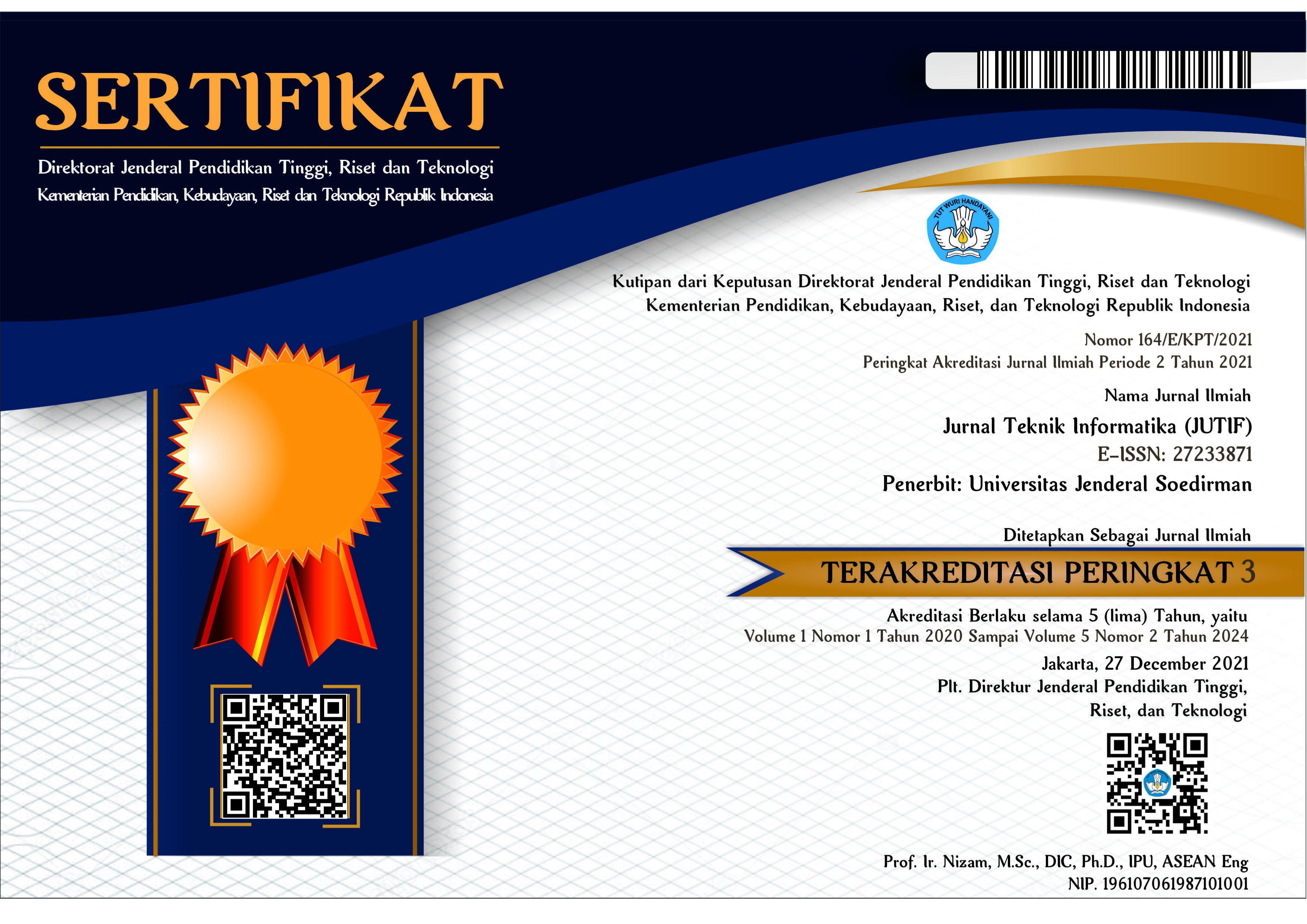IT GOVERNANCE AUDIT AT THE KAMPAR REGENCY LIBRARY AND ARCHIVES DEPARTMENT USING COBIT 2019 AND ITIL 4
DOI:
https://doi.org/10.20884/1.jutif.2022.3.6.406Keywords:
Audit, COBIT 2019, ITIL 4, IT Governance, Servqual Model and Importance Performance AnalysisAbstract
Information Technology (IT) is a tool that plays an important role in helping improve the effectiveness and efficiency of a company's or organization's business processes. The Kampar Regency Library and Archives Service uses the Integrated Library System (INLIS) Lite to support operational, management, and decision-making functions in the library. However, the use of INLIS Lite has not been fully utilized properly, for this reason it is necessary to carry out an IT governance audit. The audit process aims to determine the extent of IT performance, human resources, and the level of IT maturity in the library. This study uses Control Objective for Information and Related Technology (COBIT) 2019 and Information Technology Infrastructure Library (ITIL) 4 to conduct audits. With the findings of the audit results obtained eight process domains, namely APO02 and APO012 domains are at level 1 (Performed) in the Largely Achieved category, APO09 and BAI08 domains are at level 2 (Managed) in the Largely Achieved category, domains APO013, BAI05 and MEA01 are in the Largely Achieved, and the APO07 domain is at level 4 (Predictable) and in the Fully Achieved category. In addition to the audit, an assessment of the capability level was also carried out using the Servqual Model and Importance Performance Analysis with the results of obtaining 2 criteria in quadrant A, 1 criterion in quadrant B, 2 criteria in quadrant C and 3 criteria in quadrant D. This study also provides recommendations for improvement using SWOT model approach refers to ITIL 4.
Downloads
References
P. Fernandes, R. Pereira, and G. Wiedenhöft, “Information Technology Governance and the Individual’s Behavior: A cross-sectional study,” Australas. J. Inf. Syst., vol. 25, pp. 1–25, 2021, doi: 10.3127/ajis.v25i0.3141.
A. Vatresia, R. Faurina, and D. K. Ramadhan, “Information Technology Governance in Advisory and Economic Development Sector Using Cobit 5 Framework,” J. Tek. Inform., vol. 3, no. 2, pp. 255–260, 2022, [Online]. Available: http://jutif.if.unsoed.ac.id/index.php/jurnal/article/view/128
J. F. Andry and A. K. Setiawan, “It Governance Evaluation Using Cobit 5 Framework on the National Library,” J. Sist. Inf., vol. 15, no. 1, pp. 10–17, 2019, doi: 10.21609/jsi.v15i1.790.
P. N. R. Indonesia, “Undang-Undang Republik Indonesia Nomor 43 Tahun 2007 Tentang Perpustakaan,” 2007.
O. A. Putri et al., “Integrasi Metode Webqual 4 . 0 dan Importance Performance Analysis ( IPA ) untuk Mengukur Kualitas Website Inlis Lite,” vol. 6, no. 2, pp. 2–7, 2021.
P. I. (n. d. .Lite, “Modul inlis lite perpusnas,” Retrieved from https//inlislite .perpusnas.go.id.
E. Fatmawati, “Pengenalan Automasi Perpustakaan Terintegrasi INLISLite,” Libr. J. Ilmu Perpust. Dan Inf., vol. 9, no. 1, pp. 1–19, 2020.
H. Mayas, Zarnelly, and Megawati, “Analisis Kualitas Layanan Terhadap Kepuasan Pengguna Sistem Informasi Kawasan Agrowisata,” vol. 8, no. 1, pp. 13–19, 2022, [Online]. Available: http://ejournal.uin-suska.ac.id/index.php/RMSI/article/view/16246/7415
I. N. S. Saputra and B. Yuwono, “Pengukuran Tingkat Kapabilitas dan Perbaikan Tata Kelola Teknologi Informasi Berdasarkan Kerangka Kerja COBIT 5 dan ITIL V3 2011: Studi Kasus PT. XYZ,” Inser. Inf. Syst. Emerg. Technol. J., vol. 2, no. 1, 2021.
T. Kude, M. Lazic, A. Heinzl, and A. Neff, “Achieving IT-based synergies through regulation-oriented and consensus-oriented IT governance capabilities,” Inf. Syst. J., vol. 28, no. 5, pp. 765–795, 2018, doi: 10.1111/isj.12159.
I. M. Faniel and L. S. Connaway, “Librarians’ perspectives on the factors influencing research data management programs,” Coll. Res. Libr., vol. 79, no. 1, pp. 100–119, 2018, doi: 10.5860/crl.79.1.100.
D. Sulistyowati, F. Handayani, and Y. Suryanto, “Comparative analysis and design of cybersecurity maturity assessment methodology using nist csf, cobit, iso/iec 27002 and pci dss,” Int. J. Informatics Vis., vol. 4, no. 4, 2020, doi: 10.30630/joiv.4.4.482.
L. Moudoubah, A. El Yamami, K. Mansouri, and M. Qbadou, “From IT service management to IT service governance: An ontological approach for integrated use of ITIL and COBIT frameworks,” Int. J. Electr. Comput. Eng., vol. 11, no. 6, 2021, doi: 10.11591/ijece.v11i6.pp5292-5300.
A. Gerl, M. Von Der Heyde, R. Groß, R. Seck, and L. Watkowski, “Applying COBIT 2019 to IT Governance in Higher Education,” Inform. 2020 - Gesellschaft für Inform., pp. 517–539, 2021.
I. Pertiwi, A. Fatchur, S. Nurna, and A. Kamalia, “Audit Tata Kelola Teknologi Informasi Domain Monitor , Evaluate , and Asses dan Deliver , Service , Support Berdasarkan Framework COBIT 2019,” vol. 02, pp. 131–138, 2021, doi: 10.21456/vol11iss2pp131-138.
ISACA, “COBIT 2019 Framework: Governance and Management Objectives.,” 2018.
C. Agutter, ITIL Foundation Essentials ITIL 4 Edition-The Ultimate Revision Guide. IT Governance Publishing Ltd, 2020.
B. Verlaine, “Toward an Agile IT Service Management Framework,” Serv. Sci., vol. 9, no. 4, pp. 263–274, 2017, doi: 10.1287/serv.2017.0186.
J. R. Batmetan, M. Nur, O. S. M. Turang, and M. M. Sumampouw, “IT Infrastructure Library Framework Approach to the Measurement of e-Government Maturity,” vol. 1, no. 2, pp. 119–128, 2022.
E. Nachrowi, Yani Nurhadryani, and Heru Sukoco, “Evaluation of Governance and Management of Information Technology Services Using Cobit 2019 and ITIL 4,” J. RESTI (Rekayasa Sist. dan Teknol. Informasi), vol. 4, no. 4, 2020, doi: 10.29207/resti.v4i4.2265.
H. Fryonanda, H. Sokoco, and Y. Nurhadryani, “Evaluasi Infrastruktur Teknologi Informasi Dengan Cobit 5 Dan Itil V3,” JUTI J. Ilm. Teknol. Inf., vol. 17, no. 1, p. 1, 2019, doi: 10.12962/j24068535.v17i1.a717.
D. R. Indah, S. D. Russandwi, and M. A. Firdaus, “Implementasi Cobit 5 Pam Dan Itil V3 2011 Untuk Penilaian Kapabilitas Pada Sistem Service Desk,” JSI J. Sist. Inf., vol. 12, no. 2, 2020, doi: 10.36706/jsi.v12i2.13192.




























